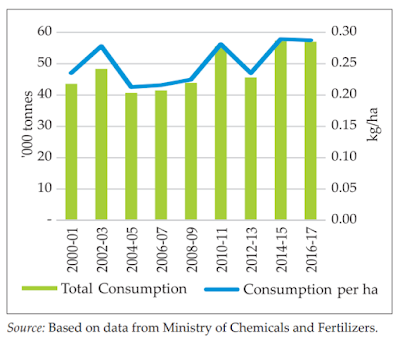Last year we heard news, many farmers died in Maharashtra due to pesticide poisoning. Initial reports suggest that the deaths are due to “Monocrotophos”: a highly toxic chemical been banned in more than 60 countries but allowed to be sold in our country. This is the same chemical that was responsible for the death of 23 children who consumed the toxic midday meal in Bihar in 2013. The chemical was completely banned by the US in 1991, because it killed huge populations of birds.
According to the Directorate
Of Plant Protection, Quarantine and Storage, 148 of the 414 metric tonnes
of weedicides consumed in the country in 2014-15 was glyphosate. In
2015-16, a little more than 370 metric tonnes of monocrotophos was used on Indian
soil.
Anupam Verma, who leads the
committee that reviews the list of 66 pesticides and their usage in the country
said that this was the first time that such a large number of pesticides were
being banned at one go. The last time a pesticide ban made news was when
endosulfan was banned by the Supreme Court after it reviewed the toxic effects
in Kerala.
Activists from Greenpeace
India questioned the seemingly arbitrary selection of 18 pesticides out of the
official list of 66. “We appreciate the government stand of banning 12 deadly
pesticides with immediate effect and six more in the coming two years. But
why out of 66 universally banned pesticides, have only 18 been banned that too
after almost five years of commissioning and three years after the
submission of the Anupam Verma committee report?” asked Sehar Iqbal, the
manager food for life campaign, Greenpeace India. “The current ban leaves out
monocrotophos and glyphosate, which still leaves farmers, farm workers and
rural families (especially children) at risk and poisons the soil affecting
farmer livelihoods, not to mention seriously compromising the health of
consumers,” she said.
Farmers apply pesticides such as chlordane, endrin and heptachor that can cause
serious neurological problems, kidney damage and skin diseases. A study
conducted by Delhi-based NGO Consumer-Voice reveals that the amount of
pesticides used in eatables in India is as much as 750 times the European
standards. The survey collected sample data from various wholesale and retail
shops in Delhi, Bangalore and Kolkata.
The vegetables studied included potato, tomato,
snake gourd, pumpkin, cabbage, cucumber and bottle gourd, among others. ‘‘We
have informed Food Safety and Standards Authority of India about the excessive
use of pesticides in fruits and vegetables that pose serious health hazards,’’
said Ghosh. He added that strict monitoring from government agencies is
required to check manufacture, import and use of banned pesticides. The
pesticide residue limits have not been reviewed for the past 30 years, said
Ghosh.
Earlier this month, the organisation had conducted
tests on fruits sold in Indian markets which again showed that 12 fruits,
including bananas, apple and grapes, had high quantity of pesticides, violating
both Indian and European Union standards. The chemical contents found in fruits
were endosuplhan, captan, thiacloprid, parathion and DDT residues.
 Consuming
pesticide-laden fruits and vegetables for a long period of time can prove
fatal. Health experts say that pesticides are neurotoxins, affecting the
nervous system and other important organs such as liver and kidney. Food
poisoning and different sorts of allergies are common from these pesticides.
Some pesticides even lead to cancer. Certain pesicides cause skin problems,
loss of weight, sleeplessness and irritability.
Consuming
pesticide-laden fruits and vegetables for a long period of time can prove
fatal. Health experts say that pesticides are neurotoxins, affecting the
nervous system and other important organs such as liver and kidney. Food
poisoning and different sorts of allergies are common from these pesticides.
Some pesticides even lead to cancer. Certain pesicides cause skin problems,
loss of weight, sleeplessness and irritability.
Usage of Pesticide in India
Insecticides, fungicides and herbicides are commonly used
for pest control in agriculture. However, insecticides form the highest share
in total pesticide use in India. Both total as well as per hectare consumption
of pesticides in India show significant increase after the year 2009-10.
In the year 2014-15, pesticide consumption was 0.29 kg/ha
(GCA), which is roughly 50 per cent higher than the use in 2009-10. The recent
increase in pesticide use is because of higher use of herbicides as cost of
manual weed control has risen due to increase in agricultural wages (FICCI,
2015).
Pesticide consumption is the highest in Maharashtra,
followed by Uttar Pradesh, Punjab and Haryana During the last decade, the total
consumption increased in Maharashtra and Uttar Pradesh, while it slightly
declined in Punjab and Haryana. States like West Bengal, Gujarat and Karnataka
have seen a steep decline in the total consumption. On the other hand, Chhattisgarh
and Kerala showed a steep increase in total pesticide consumption. Per hectare
consumption of pesticides was the highest in Punjab (0.74 kg), followed by Haryana (0.62 kg) and Maharashtra (0.57 kg)
during the year 2016-17, while the consumption levels were lower in Bihar,
Rajasthan,Karnataka and Madhya Pradesh.



Comments
Post a Comment